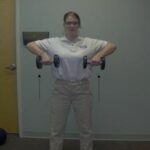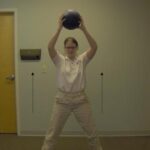Imagine waking up one morning and discovering that you can’t raise one of your shoulders. Not that it merely hurts to do so, but it just won’t move at all. Like all the bones have been locked in place. You’re in pretty good shape, haven’t been injured, and have no clue what you might have done to bring this on. And you also can’t lift your arm. Not only does this make your job – let alone driving to your job – difficult, but it limits your wardrobe choices to things that either slip easily over your head (wide necks and stretchy fabrics only!) or button up the front. Not the simplest of tasks for a professional woman.
About as bad is the reaction you get from your doctor. He merely shrugs, prescribes some pills that don’t work, and refers you to specialist after specialist before you simply give up.
This happened to me. And I didn’t know what the heck was going on. I exercised regularly – although I tended to “injure easily” – and I often worked hunched over a drafting table, but couldn’t think of a thing I might have done to hurt myself so grievously. I didn’t know until I took my strange, stiff self to my chiropractor that I had what was creatively called a “frozen shoulder.” And as he poked around some more and then reviewed my history, he told me that I wasn’t just someone who got “injured easily,” but I had a condition called “chronic myofascial pain syndrome.” (also known as “MPS”)
The myofascia is the thin membrane that surrounds all of your muscles, protecting them from injury and aiding them in the circulation of blood and elimination of waste materials such as lactic acid. Think of it as a kind of flexible netting holding everything in place. Normally, the myofascia is of a gel-like consistency and allows movement of muscles through their full range of motion. But sometimes, following childbirth, injury, or long periods of misuse or poor posture (like me, working hunched over a drafting table) the myofascia can harden, or gets “stuck” to the muscles or other soft tissue, which can exacerbate injuries and inhibit muscle movement and circulation.
I was also told that at that time there was no cure for MPS, but “incidents” like mine (and more that would occur in my future) could be managed. To treat my frozen shoulder, I worked with a chiropractor, a massage therapist, and did some work that both recommended I do at home. The chiropractor started with ultrasound to heat the muscles and bring blood to the area. Eventually this broke up adhesions and allowed him to do gentle adjustments. The massage therapist carefully worked the muscles involved and did what is called “myofascial release,” which is exactly as it sounds: a massage technique where the “stuck” myofascia is released from the muscles and other soft tissues. At home, I alternated heat and cold treatments to the shoulder and trapezius muscle in order to improve circulation, and performed some targeted stretching exercises. And eventually, I found relief.
That was over fifteen years ago, and like nearly all medical treatments, things have changed. The medical community, according to Dr. Devin Starlanyl, a leading authority on fibromyalgia and myofascial pain, has now reached the consensus that MPS still exists, but is classified as a neuromuscular disease. It is caused by “trigger points,” which are knot-like constrictions in the myofascia and the muscles that inhibit normal muscle movement and cause pain. The localized area is starved for oxygen, which causes more the pain and immobility. The lymphatic system cannot relieve muscular waste products in the area, and that causes additional pain. It’s not until the trigger points are deactivated (by several techniques, the most common of which is sustained deep-tissue massage over the trigger point itself) that full range of motion can be and normal circulation can be restored in the muscle. And sometimes, since few doctors buy into the concept of trigger points, some conditions that could be easily treated by eliminating the trigger points are misdiagnosed, leading to unnecessary surgeries, medication or additional agony.
For instance, I had another such “incident” before my wedding (before I knew about trigger points), and instead of suspecting that myofascial problems might be causing the pain that had cropped up in my elbows, wrists and hands, my doctor sent me to physical therapy for treatment of tendonitis. The PT exercises caused even greater pain and it wasn’t until I began working intensely with my massage therapist again did I get any relief.
While I can’t completely eliminate my myofascial problems forever (because I’m prone to MPS, many physical activities that most people do without problems can perpetuate trigger points in my muscles), there is a lot I can do to keep them under control. Regular exercise and stretching can prevent the reoccurrence of trigger points. A healthful diet is good for anyone with a chronic condition and drinking lots of water helps the body eliminate wastes. Not remaining in one position for more than thirty minutes or so also helps the myofascia stay loose. And there are several good guidebooks on the market that show the location of common trigger points and explain how to deactivate them using specialized ergonomic self-massage techniques. One of my favorites is “The Trigger Point Therapy Workbook,” by Clair Davies, NCTMB. Locating them can be frustrating because a pain in your elbow, for example, could be caused by a point in your upper arm or even in your shoulder. (I’m working on an elbow pain right now…turns out that massage to a point in my tricep muscle is giving me the most relief.) More stubborn points or things I can’t reach I leave for my massage therapist. But it’s tremendously empowering to know that I can do things to improve my own condition and don’t have to rely completely on bodyworkers for relief.
And sometimes just knowing that I can take care of myself when I have a physical problem can help reduce the pain. Or at least the pain in my checkbook.






